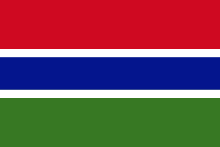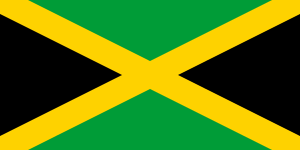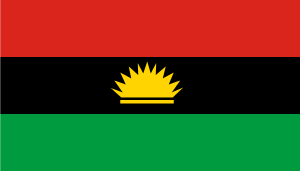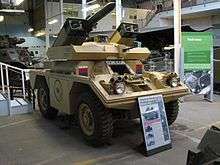Ferret armoured car
| Ferret Scout Car | |
|---|---|
 Ferret Mk.1/2 in desert finish | |
| Type | Wheeled armoured fighting vehicle |
| Place of origin | United Kingdom |
| Service history | |
| In service | 1952 - 1971 (UK) |
| Wars |
Malayan Emergency Algerian War[1] Aden Emergency Biafra War Black September Dhofar Rebellion Rhodesian Bush War Portuguese Colonial War[2] Lebanese Civil War Somali Civil War South African Border War First Sudanese Civil War Second Sudanese Civil War Suez Crisis Sri Lankan Civil War Ugandan Bush War Internal conflict in Myanmar Iran–Iraq War Invasion of Kuwait Syrian Civil War |
| Specifications | |
| Weight | 3.7 t |
| Length | 12 ft 2 in (3.7 m) |
| Width | 6 ft 3 in (1.91 m) |
| Height | 6 ft 2 in (1.88 m) |
| Crew | 3 (commander, driver & radio operator) |
|
| |
Main armament |
7.62×51mm NATO GPMG if fitted .30 M1919 Browning machine gun |
Secondary armament | none |
| Engine |
Rolls Royce B60 Inlet over Exhaust I6 petrol 130 hp (97 kW) |
| Power/weight | 35.1 hp/tonne |
| Suspension | 4x4 wheel |
Operational range | 190 mi (310 km) |
| Speed | 58 mph (93 km/h) |
The Ferret armoured car, also commonly called the Ferret scout car, is a British armoured fighting vehicle designed and built for reconnaissance purposes. The Ferret was produced between 1952 and 1971 by the UK company Daimler. It was widely adopted by regiments in the British Army, as well as the RAF Regiment and Commonwealth countries throughout the period.
History
The Ferret was developed in 1949 as a result of a British Army requirement issued in 1947. 'Light reconnaissance cars' existed during the Second World War, notably the Daimler Reconnaissance Scout Car.
Given its experience with the successful "Dingo" (6,626 produced and one of two British AFVs produced throughout WWII) Daimler was awarded a development contract in October 1948, and in June 1950 the first prototype of the Car, Scout, 4x4, Liaison (Ferret) Mark 1 was delivered.
Given the designation FV 701(C) it was one of several versions but the one that most closely resembled the original Daimler scout cars, and represented the basic model Ferret. This shared many similar design features with the Dingo, notably the H form drive train in which a central differential eliminates loss of traction due to wheel-slip, and parallel drive shafts considerably reduced the height of the vehicle (roughly equivalent to that of a tracked AFV), considerably reducing the vehicle's visual signature over conventional armoured car designs.[3]
Like the Daimler scout car the Ferret suspension consisted of pairs of transverse links and single coil springs, the wheels driven by Tracta constant-velocity joints, but the Ferret benefited from epicyclic reduction gears that reduced transmission torque loads, essential given the more powerful six cylinder 4.26 litre water-cooled Rolls Royce B.60 petrol engine. Connected by a fluid coupling to a pre-selector five speed epicyclic gearbox, all gears being available in reverse, in its original form the Ferret this installation produced 116 bhp at 3,300 rpm and 129 bhp at 3,750 in its final form.
This improved power-to-weight ratio, longer wheelbase (2.29 m (7.5 ft) as compared with the Dingo's 1.98 metres (6.5 feet)) and the fitting of larger 9.00 x 16 run flat tyres both increased speed and mobility over broken ground.
When compared with the Daimler Dingo and Canadian Ford Lynx, the Ferret featured a larger fighting compartment, directly mounted to the hull (a feature that made the Ferret much noisier than Dingo, which lacked a fully monocoque body).
Constructed of 6–16 mm (0.24–0.63 in) steel plate protecting the crew from shell splinters at most angles except directly overhead, as the basic vehicle was open-topped and unarmed, with the exception of six forward-firing grenade launchers fitted to the hull over the front wheels (normally carrying smoke grenades), a feature found on all subsequent marks and models.
However, the Ferret normally carried a defensive fit of a .303in Bren light machine gun or pintle-mounted .30in Browning light machine gun[3] in addition to the crew's personal weapons.
Ferret Mark 2
In contrast to the lightly armed and protected Mark 1, which could carry a .303in Bren or pintle-mounted .30in Browning light machine gun, the Mark 2 was designed from the outset to mount a .30in Browning in a one-man fully traversable turret, at the cost of one crew member. While this offered better crew protection and protected the otherwise dangerously exposed gunner, the turret raised the height of the vehicle and thus made it more conspicuous; in consequence the choice of fit depended on the nature of the mission.
In general terms the most successful wheeled armoured vehicles have been purpose-designed and the lightest, commensurate with their mission, being at the least disadvantage in relation to tracked vehicles in terms of ground pressure, which largely governs off-road performance.[3]
Small and fast enough to be useful in an urban environment, but sufficiently strong and agile to negotiate rugged terrain off-road, the Ferret, while no longer in service in the British Army, is still operated by several Commonwealth countries and has proven popular with private collectors due to the compact size and affordable price, e.g. around $20,000 to $30,000 in the United States, $40,000 to $60,000 in Australia and New Zealand and around $9,000 in the Czech Republic.[4]
Mark 1 and Mark 2 Ferrets were used by Australian Military forces from 1953 to 1970, at which time Australian military forces disposed of them at public auction.
According to the US Military, 20 national armies were operating the Ferret in 1996.[5]
Production
A total of 4,409 Ferrets, including 16 sub-models under various Mark numbers, were manufactured between 1952 and 1962, when production ceased. It is possible to upgrade the engine using the more powerful FB60 version from the Austin Princess 4-Litre-R; this upgrade providing a 55bhp gain over the standard B60 engine.
Operators


Current operators





















Former operators








.svg.png)


.svg.png)





.svg.png)





Variants
There are several Marks of Ferret, including those with varying equipment, turret or no turret and armed with Swingfire anti-tank missiles. Including all the marks and experimental variants, there have probably been over 60 different vehicles.
- Mk 1
- FV701C
- Liaison duties
- No turret
- Armament .30 Browning MG
- MK 1/1
- Fitted with thicker side and rear hull plates during manufacture
- Sealed hull for fording
- Armament .30 Browning MG
- Mk 1/2
- As Mk 1/1 but fitted with fixed turret with hinged roof door
- Crew of three
- Armament Bren LMG, later GPMG
- Mk 1/2
- As Mk 1/1 but fitted with flotation screen
- Armament .30 Browning MG
- Mk 2
- Original reconnaissance vehicle with 2-door turret from Alvis Saracen APC
- Armament .30 Browning MG
- Mk 2/1
- Original Mk 1 with 2-door turret from Alvis Saracen APC
- Armament .30 Browning MG with Bren LMG stowage
- Mk 2/2
- Original Mk 1 with extension collar and 3-door turret
- Armament .30 Browning MG
- Mk 2/3
- As original Mk 2 but fitted with thicker side and rear hull plates during manufacture
- Armament .30 Browning MG
- Mk 2/4
- Original Mk 2 but fitted with welded-on appliqué on side and rear of hull and turret
- Armament .30 Browning MG
- Mk 2/5
- As Mk 1 fitted with appliqué plates as the Mk 2/4
- Armament .30 Browning MG with Bren LMG stowage
- MK 2/6
- FV703
- As Mk 2/3 converted as carrier for *Vigilant antitank missile
- Armament .30 Browning MG and four missiles mounted in boxes, two on each side of turret
- Used by British Army and Abu Dhabi
- Mk 2/7
- FV701
- As Mk 2/6 stripped of anti-tank missiles after Vigilant withdrawn from service
- Mk 3
- Basic hull for Mk 4 and 5
- Larger wheels
- Heavier armour
- Stronger suspension
- Flotation screen
- Mk 4
- FV711
- Reconnaissance vehicle with 2-door turret from Alvis Saracen APC
- Also Mk 2/3 rebuilt to new specification
- Armament .30 Browning MG

- Mk 5
- Ferret 80
References
- ↑ http://tenes.info/nostalgie/BLINDES/Auto_Mitrailleuse_AM_20_dans_le_Constantinois
- ↑ Abbott, Peter; Rodrigues, Manuel (1998). Modern African Wars 2: Angola and Mozambique 1961-74. Osprey Publishing. p. 11.
- 1 2 3 Ogorkiewicz, R.M. (1972). AFV Profiles 44 Ferrets and Fox. Profile Publications Ltd.
- ↑ http://earmyshop.cz/vozidlo-ferret
- ↑ Anti-Armor Weapons Subcourse
- 1 2 3 4 5 6 7 8 9 10 11 12 13 14 15 16 17 18 19 20 21 22 23 24 25 26 27 28 29 30 31 32 33 34 "Trade Registers". Armstrade.sipri.org. Retrieved 2015-11-03.
- 1 2 3 4 Christopher F. Foss. Jane's World Armoured Fighting Vehicles (1976 ed.). Macdonald and Jane's Publishers Ltd. pp. 156–157. ISBN 0-354-01022-0.
- ↑ Christopher F. Foss. Jane's Tanks and Combat Vehicles Recognition Guide (2000 ed.). Harper Collins Publishers. pp. 386–391. ISBN 978-0-00-472452-2.
- ↑ "Pakistan Land Forces military equipment and vehicles of Pakistani Army".
- ↑ Richard Lobban, Jr. Global Security Watch: Sudan (2010 ed.). Greenwood Publishing Group. p. 182. ISBN 978-0-313-35332-1.
- ↑ Jowett, Philip (2016). Modern African Wars (5): The Nigerian-Biafran War 1967–70. Oxford: Osprey Publishing Press. pp. 24–46. ISBN 978-1472816092.
- ↑ https://captainstevens.com/military/mv/ferret-scout-car/canadian-ferrets-all-124-by-car/
- ↑ Defence Update (International). Defence Update G.m.b.H., 1984, 1984–85 Volume Collected Issues 48–58.
- 1 2 Christopher F. Foss. Jane's Armour and Artillery (2002 ed.). Macdonald and Jane's Publishers Ltd. p. 260. ISBN 978-0710623096.
- ↑ Keegan, John (1983). World Armies (Second ed.). Basingstoke: Palgrave-Macmillan. ISBN 978-0333340790.
- ↑ "Lesakeng". South African Armour Museum. 6 December 2012. Archived from the original on 3 July 2013. Retrieved 2013-06-18.
- ↑ Simon Baynham. Zimbabwe in transition (October 1992 ed.). Almqvist & Wiksell International. p. 240. ISBN 978-9122015086.
External links
- Ferret Scout Car in Canadian Service
- Warwheels.net
- Ferret Walk Arounds on Prime Portal
- The Ontario Regiment (RCAC) Ferret Club, Oshawa, Ontario, Canada
- King's Own Royal Border Regiment Museum, Carlisle Castle, Cumbria, England has an example on display
| Wikimedia Commons has media related to Ferret armoured car. |